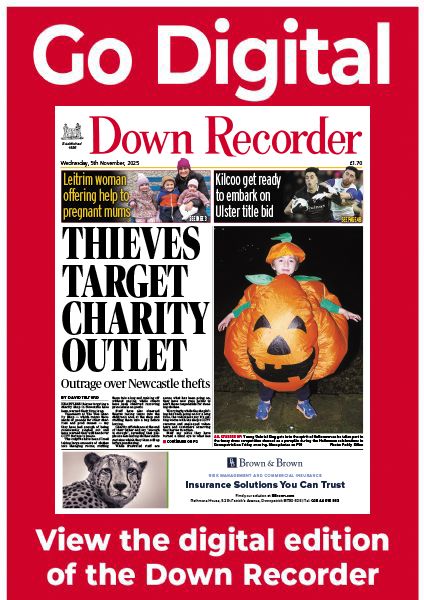St Patrick under pressure as new tourist strategy heads outdoors
St Patrick under pressure as new tourist strategy heads outdoors
14 December 2016
THE St Patrick story has been considerably downgraded in a major new tourist strategy for the district.
In what represents a significant shift in direction, the new five-year draft strategy is focusing on adventure and natural tourism and increasing the number of people visiting the Mournes, forest parks, coastal areas and waterways.
The strategy — which aims to ensure the Newry, Mourne and Down Council area becomes one of Ireland’s premier tourist destinations by 2019 — makes little reference to the multi-million pound St Patrick Centre in Downpatrick or identify it as a key player moving forward.
The St Patrick Centre is the world’s only dedicated centre to the patron saint, but this cuts little ice with the strategy authors who argue the district has no flagship visitor attraction.
The centre was the centrepiece of the St Patrick Signature Project, one of a number of major tourism initiatives identified several years ago by the Tourist Board to attract increasing numbers of visitors to the Province. But the new strategy appears to announce a major shift in policy away from the St Patrick story towards more natural resource tourism.
The new tourism blueprint is the single most important document Newry, Mourne and Down Council will produce during its first term and is viewed as a road map to ensure the district becomes Northern Ireland’s premier outdoor and adventure destination. The strategy is set for its formal launch in the New Year.
Written with a “mountains, myths and maritime” theme, the strategy’s focus is on creating “destination experiences” that are associated with the mountains and the coastline in an area which generated almost £50m in tourism income last year in a sector which supports 5,000 jobs.
The strategy — which aims to achieve a six per cent increase in overnight stays in the district — says the lack of hotel accommodation in Downpatrick and in other parts of the district is an issue which needs to be addressed and also confirms the importance of a new cable car ride into the heart of the Mournes.
The report says visitors do not stay long in Downpatrick as a result of a lack of overnight accommodation. It says while the town benefits from the significant number of tour buses which visit the St Patrick Centre, there are not enough beds for them to stay longer. The town’s night time economy is branded “weak” with restaurant provision described as “limited.”
Town centre congestion is highlighted and despite the completion of a £3m public realm initiative a number of years ago, Downpatrick has a “tired look” according to the new strategy. It says while the St Patrick theme is the town’s point of differentiation, there is little activity to tell the story in Downpatrick, beyond the centre dedicated to the patron saint. The strategy says Centre staff have a significant role to play in assisting visitors how they can experience the St Patrick story outside of the facility.
Turning to the cable car ride into the Mournes which is described as a “regional priority,” the strategy views its provision as a potential game changer in the drive to help attract more visitors, helping create new jobs and economic opportunities.
It has been suggested the ride, which would be the first of its kind in Ireland, would transport visitors from Donard Park to the quarry on Thomas Mountain.
The provision of wet weather facilities in the resort are viewed as important, with the strategy suggesting their provision could lead to longer stays and greater visitor spend. The need to strengthen the resort’s night time economy is also highlighted.
The success of mountain bike trails in Castlewellan and Rostrevor is emphasised in the strategy with the report highlighting the importance of further developing them and improving access to the higher Mournes.
Elsewhere, the strategy says the Mourne Coastal Experience, which includes a series of driving and walking trails stretching from Strangford Lough to Carlingford Lough, embraces much of the St Patrick Story through its proximity to Downpatrick. It says there is a need for a more co-ordinated and integrated approach to developing and marketing the routes.
The need to improve access to beaches and waterways across the district also features in the tourism blueprint which says the local coastline has the potential for offering a range of water-based activities. It is suggested an inventory of coastline access is undertaken to help identify strategies to improve tourism benefits.
Good boat access to Strangford Lough in particular is described as “problematic” with the report suggesting this is constraining the growth of recreational boating and yachting in the area. Assessing the reinstatement of a public transport service to the Strangford and Lecale area is also highlighted with the report suggesting local business owners should be involved in discussions about how a new service would be viable. Culinary tourism is also identified as a potential growth area.
Securing so-called UNESCO geo park status for an area which would include the Mournes, Ring of Gullion and Cooley Peninsula, is suggested as a “catalyst project” to help grow the geo-tourism economy.
The draft strategy suggests formal geo-park recognition brings with it European and global significance, helping provide a much stronger market identity and allowing a new management infrastructure to be introduced.


